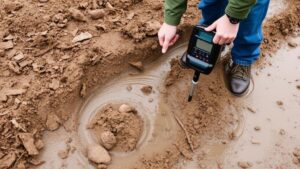Detecting Along Riverboat Landings for Lost Coins and Silverware
Detecting Along Riverboat Landings for Lost Coins and Silverware
The search for lost coins and silverware along historic riverboat landings combines the allure of treasure hunting with the rich tapestry of American history. As riverboats facilitated trade and travel during the 19th century, they also became sites where valuables could easily be lost or discarded. This article explores the methodologies for effectively detecting these treasures, delving into the historical context, technological considerations, and practical field techniques.
Historical Context of Riverboat Landings
In the 1800s, riverboat landings played a crucial role in commerce and transportation along Americas rivers, particularly the Mississippi and Ohio rivers. e landings served as busy hubs where passengers embarked and disembarked, merchants traded goods, and social gatherings occurred. Given the frequent movement of people and goods, it is not surprising that many valuable items, ranging from coins to silverware, were lost or left behind.
For example, the town of Natchez, Mississippi, known for its grand antebellum homes and rich riverboat history, is said to have been a hotspot for lost treasures. During the height of riverboat travel, it is estimated that millions of dollars worth of goods exchanged hands, leading to numerous opportunities for valuable belongings to be misplaced or discarded.
Understanding the Terrain
Detecting along riverboat landings requires a solid understanding of the geographical and hydrological characteristics of the area. Riverbanks can change dramatically due to erosion, flooding, and sediment deposition. Here are some factors to consider:
- Soil Composition: Sandy or loamy soils are more conducive to retaining small metallic objects compared to clay or rocky terrains.
- Water Level History: Knowing the historical water levels can help pinpoint former landings that are now underwater or have been significantly altered.
- Erosion Risks: Areas experiencing high erosion rates may yield more discoveries as shifting soils can reveal buried treasures.
Detector Types and Technology
Choosing the right metal detector is paramount for successful treasure hunting. Various types of detectors excel in different conditions and types of targets:
- VLF (Very Low Frequency) Detectors: These are commonly used for coin and relic hunting due to their sensitivity to metal, making them ideal for areas with a lot of trash.
- PI (Pulse Induction) Detectors: These are better suited for saltwater environments and can penetrate deeper into the ground, making them useful along riverbanks.
For example, the Minelab Equinox series has gained popularity among hobbyists for its multi-frequency technology, allowing it to detect various metals and adjust settings based on the conditions of the search area.
Field Techniques for Effective Detection
Successful metal detecting requires more than just the right equipment; it also necessitates effective field techniques. Here are some strategies to maximize treasure-finding potential:
- Grid Searching: Divide the area into a grid and systematically search each section to ensure thorough coverage.
- Use of Ground Balancing: Properly ground balancing your detector helps reduce false signals caused by mineralization in the soil.
- Timing: Early morning or late afternoon is often best for detecting, as cooler temperatures can reduce noise and enhance sensitivity.
Case Studies and Real-World Applications
Numerous treasure hunting enthusiasts have reported successes in locating lost coins and silverware along riverbanks. For example, in 2019, a group of detectivists in Missouri unearthed a trove of 1870s silverware near a former riverboat landing, which, upon appraisal, was valued at over $15,000. Such discoveries illustrate the potential rewards of understanding the history and employing proper detection techniques.
Legal Considerations and Ethics
While the thrill of discovery is enticing, it is essential to consider the legal and ethical implications of treasure hunting. Local laws vary significantly regarding the ownership of recovered artifacts. Here are some general guidelines to follow:
- Permits: Always check for required permits for metal detecting in public areas, as many localities have specific regulations protecting cultural resources.
- Reporting Finds: Report significant historical finds to local authorities or historical societies, contributing to the preservation of local heritage.
Actionable Takeaways
Detecting along riverboat landings can uncover invaluable pieces of history. As you prepare to embark on your own treasure-hunting journey, consider the following:
- Research the history of your target area to identify former landing sites.
- Select the appropriate metal detector based on your environment and target type.
- Use effective field techniques, including proper grid searches and timing.
- Adhere to local laws and ethical practices to ensure responsible treasure hunting.
By approaching your treasure hunting endeavors with a thoughtful and informed mindset, you may not only find lost coins and silverware but also contribute to the ongoing dialogue about Americas historical rivers and their significance.



